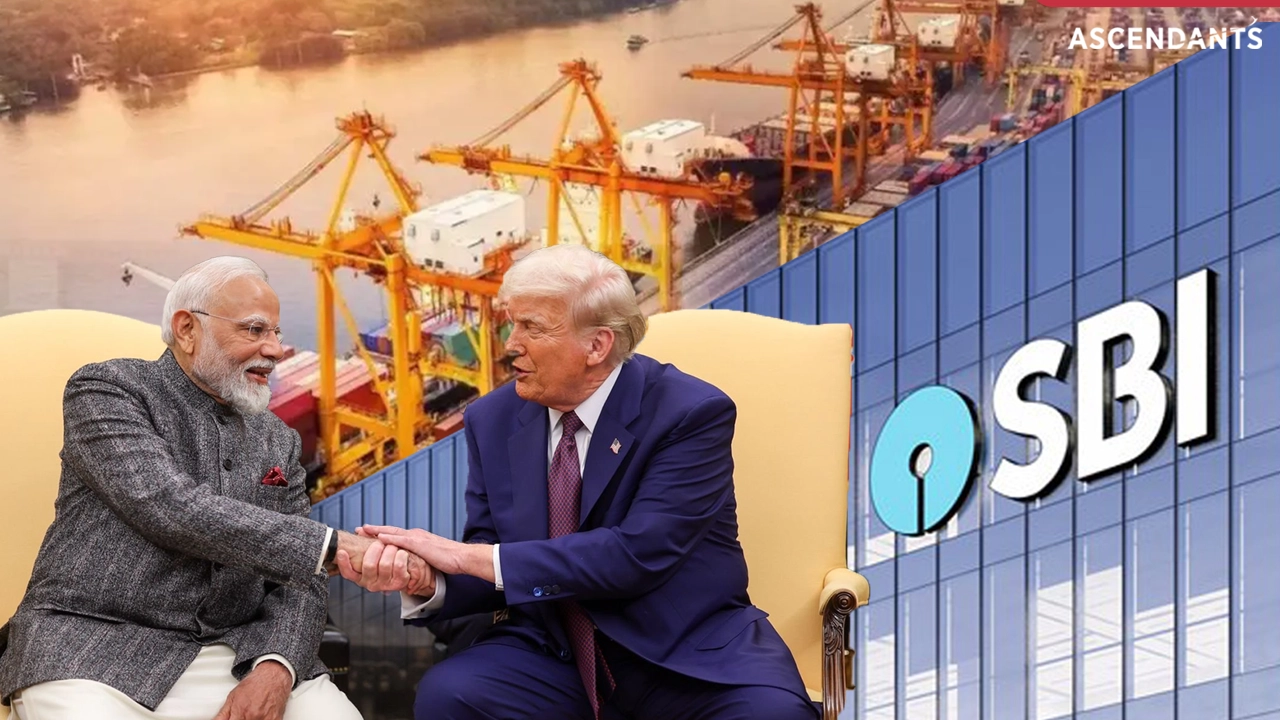India’s economy is still not much affected by the retaliatory tariffs, imposed by the United States on imports from the nation, a State Bank of India (SBI) Economic Research Department report revealed, which was released on Monday. The report is predicting that rising tariffs of 15 to 20 per cent would at best affect Indian exports to America partially and would slow down the fall to as low as 3 to 3.5 per cent.
A Balanced Global Trade Strategy
The SBI report finds India’s strategic flexibility amid the changing trade policy of the world. It proposes that India’s value-added export strategy, diversified basket of exports, and search for new trade channels have made it more robust. These efforts along with continued measures to restore international supply chains negate the potential negative impacts of US tariffs.
We believe that the accommodative stance by the policymakers and the leadership must bring the incremental tariff rate overall to 15-20 per cent. This will keep the adverse impact on exports within 3-3.5 per cent, which could be compensated by more ambitious export targets in manufacturing and services, the report further added. It also brought to the fore India’s emerging trends of trade policy, significantly new supply chain connections between the US and Europe and the Middle East for the resilience of the country’s economic landscape.
Bilateral Negotiations: A Silver Lining
Apart from rhetoric of tariffs, there is some silver lining in the SBI report that bilateral talks between India and US may have some positive payoff for the unlikeliest of outcomes. While US’s ‘Fair & Reciprocal Plan’ would aim to put an end to what it sees as decades of trade deficits, the ongoing trade negotiations can yield strategic dividends for India for good.
“A crucial component of the white noise in the larger markets at the tariff influence level for India is known to us. But we understand overall bilateral talks spill over economically if not politically in some degree,” the report went on.
Sectoral Cooperation and Sectoral Regime
In the face of economic turmoil everywhere in the world, as well as other American tariffs, the report calls for collaboration in all areas of relevance. It recommends individual cooperation from Defense, Energy Security, Innovations, Technology, Critical Minerals, Maritime Security, Investments, and Higher Education because it would make India a robust strategic ally to the US.
By establishing the culture of facilitative dynamism, India being the largest and most vibrant democracy in the world is a natural ally to the US in the Indian Ocean region both strategically and economically, the report clarified.
Evolution of Tariff Policies
Referring back to the trend of tariffs through history, the report provides a summary of some of the rates of tariffs imposed by a nation on another. US tariff on Indian imports increased from 2.72 percent in 2018 to 3.91 percent in 2021 before it went down slightly to 3.83 percent in 2022. Conversely, India’s import tariffs from the United States have increased dramatically from 11.59 percent in 2018 to 15.3 percent in 2022 and reflect an adjustment of the economy to altered economic priorities and the trade policy.
US Tariff Rates on India:
| Year | Tariff (%) |
|---|---|
| 2018 | 2.72 |
| 2019 | 3.84 |
| 2020 | 3.83 |
| 2021 | 3.91 |
| 2022 | 3.83 |
India’s Tariff Rates on US:
| Year | Tariff (%) |
| 2018 | 11.59 |
| 2019 | 13.42 |
| 2020 | 12.22 |
| 2021 | 12.52 |
| 2022 | 15.3 |
(Source: SBI)
Understanding Reciprocal Tariffs
Reciprocal tariffs are where both nations impose duty on imports and exports of each other to an equal duty level. Tariffs that not only balance everything into proportion and size within the economy and offer protection for industries in the country, yet also make foreign trade stay viable, respectively. While being looked at economically as a policy of protectionism, reciprocal tariffs also compels nations to negotiate in a strategic way such that they may be able to consolidate trade relations.
Conclusion
Though the US counter-retaliatory Indian tariffs will be a temporary blow, India’s new trade policies, sectoral collaboration, and bilateral diplomacy will modulate the effect. As the global landscape of international trade policies is witnessing a sea change, India’s resilience and flexibility will be the guaranty for pursuing its economic growth narrative. With a fair plan of action in world trade, India can deal with the issue of world trade and remain an even greater contender in world markets.
Read Also: Indian GDP aims at 6.3-6.8% Growth in 2025-2026: Economic Survey























